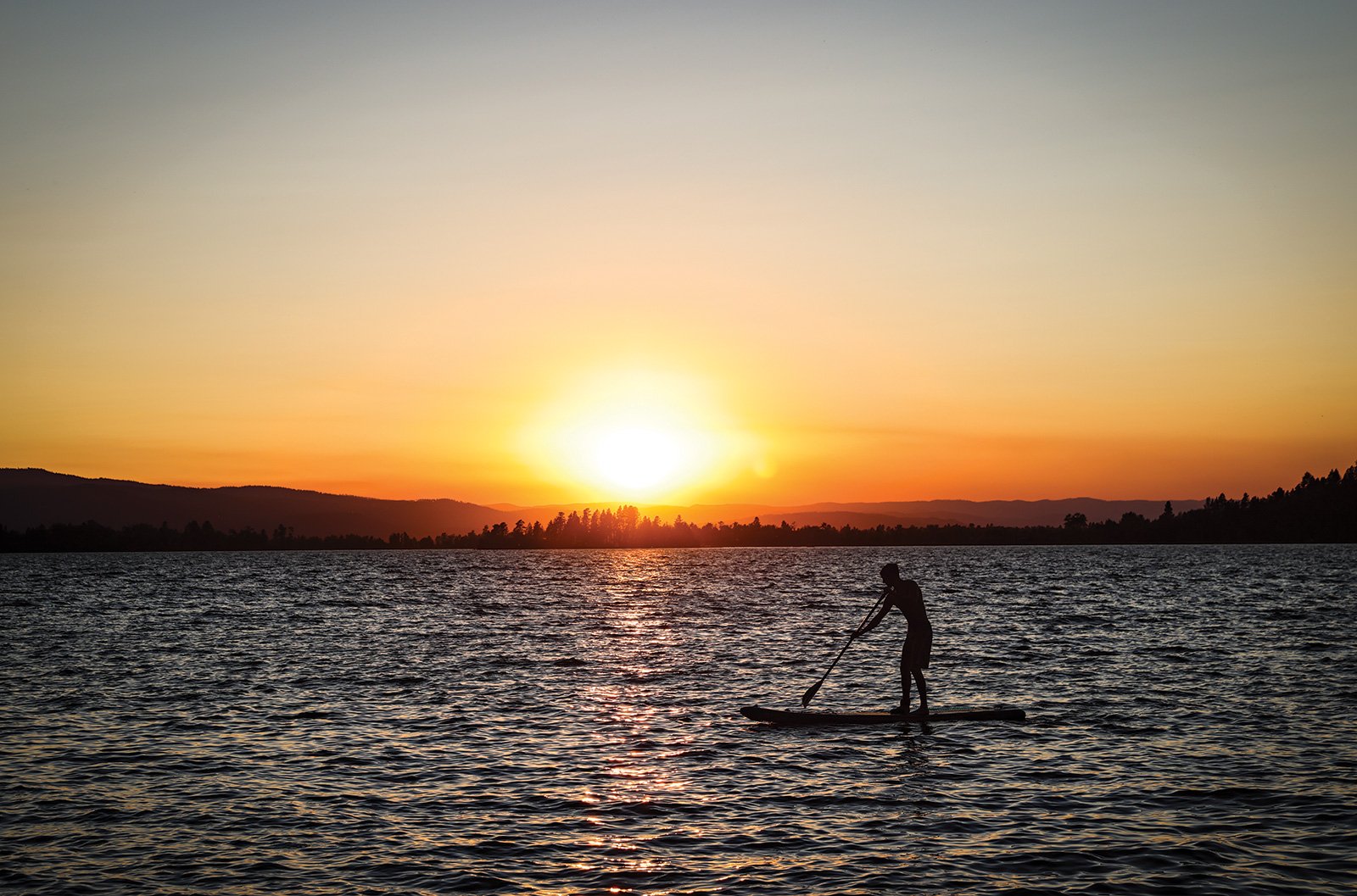Community Members, Local Leaders Outline Future for Outdoor Recreation in Bigfork Area
A paddleboarder makes his way toward shore at sunset at Wayfarers State Park on Flathead Lake in Bigfork on July 23, 2021. Hunter D’Antuono | Flathead Beacon
Environmental leaders and community members discussed priorities and concerns for sustainable recreation at a Bigfork Outdoor Recreation Alliance meeting
BY DENALI SAGNER
NOVEMBER 19, 2022
Community members and local environmental leaders gathered at Bigfork High School on Nov. 16 to discuss a path forward for the town’s outdoor recreation economy as a part of the Bigfork “Recreation Connection Action Plan” (RCAP) community input meeting. Organizers, who represented government bodies and Flathead Valley nonprofit organizations, emphasized the importance of community input in mapping out priorities for outdoor infrastructure and maintenance in the area going forward. Throughout the course of the evening, organizers and attendees discussed issues of trail creation and maintenance, parking, water access and balancing local concerns with seasonal tourism needs.
“We really need a bigger plan for outdoor recreation in the greater Bigfork area,” Flathead Lake State Park Manager Amy Grout said in an opening address to the roughly 30 meeting attendees.
The Bigfork RCAP is a project of the Bigfork Outdoor Recreation Alliance (BORA), a coalition of community groups in the greater Bigfork area, which is organized by the Montana Access Project. BORA members include the U.S. Forest Service, PacifiCorp, Flathead Lake Lodge, Community Foundation for a Better Bigfork, the Bigfork Chamber of Commerce, Bigfork Rotary, the Whitney Family, the Montana Department of Fish, Wildlife and Parks, Flathead Land Trust, and the Trust for Public Land. Montana Access Project is a Whitefish-based nonprofit that brings together local governments, community organizations, businesses and public agencies to help the communities that serve as access points to Montana’s natural landscape create sustainable frameworks for outdoor recreation.
According to the Recreation Alliance, the Bigfork Action Plan, which will serve as a “community-led road map,” will “inventory existing and potential recreation destination/connections” in the Bigfork area and will “recommend goals and objectives for sustainable recreation use.”
At the community meeting, Grout and Diane Conradi, an attorney and the founder of Montana Access Project, emphasized the importance of gathering community input before the group moves forward with a formal plan. Conradi stressed “community vitality and health” as BORA’s first priority, setting the project apart from others in Montana that have centered around development and tourism.
“It’s about being able to live, work and play in a community,” Conradi said.
After a short presentation by Conradi and Grout, attendees were invited to share their vision for the future of outdoor recreation in Bigfork and in the natural areas that the town serves as a gateway to, namely the North Shore of Flathead Lake, Echo Lake, the Jewel Basin, Crane Mountain and Woods Bay. Participants emphasized a need for increased bike paths in and around Bigfork, public beach and fishing access, dog-friendly open spaces, trail maintenance, weed control and more accessible parking.
Byron Whitney, whose family has lived in Bigfork since the early 1900’s and owns land that the Swan River Nature Trail passes through, discussed the deterioration his family saw on the trail during the pandemic. While planning for new infrastructure projects is important, maintenance and management of existing trails is a priority for his family, Whitney told the Beacon.
Though meeting leaders emphasized that the project would prioritize the needs of Bigfork residents, some attendees expressed skepticism about the prospect of driving visitors to the area, reflecting a pushback to development and increased tourism that has touched communities across the Flathead Valley. Throughout the night, attendees emphasized maintaining the secluded and quiet nature of the Bigfork area as one of their principal concerns.
One attendee questioned Grout about BORA’s intentions, saying that he believed the most sustainable path forward would be to leave the infrastructure as it is, rather than carry out renovations and improvements that may increase visitation. Grout emphasized that tourism is an inevitable part of the Flathead Valley’s economy, and that without a plan for the future, trails and natural access points would ultimately deteriorate, making them inaccessible for locals and visitors alike.
“We’re going to have to find some middle ground on things. We have differing opinions,” Grout said to the group in a closing address.
This winter, the Recreation Alliance will complete the community engagement phase of the Recreation Connection Action Plan before moving into planning and implementation.
The group will host a virtual community meeting on Nov. 21 from 6 – 8 p.m. for those who were not able to attend the recent session. More information can be found by visiting mtaccessproject.com/bigfork-area-outdoor-recreation-plan/ or emailing team@mtaccessproject.com.
